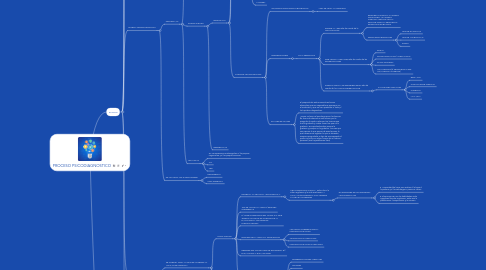
1. PASOS
1.1. PRE ENTREVISTA
1.1.1. MOMENTOS
1.1.1.1. REMOTO
1.1.1.2. ZONA DE IMPACTO
1.1.1.3. MOMENTO CERCANO
1.2. ENTREVISTA INICIAL
1.2.1. ESTABLECIMIENTO DEL MOTIVO DE CONSULTA
1.2.2. ANALISIS DE LO LATENTE A TRAVES DE LO MANIFIESTO
1.2.3. ENCUADRE Y CONTRATO (honorarios, dias, etc)
1.3. ENTREVISTA DE HISTORIA VITAL
1.3.1. ENTREVISTA SEMIDIRIGIDA QUE SE ORGANIZA EN 3 BLOQUES TEMATICOS
1.3.1.1. PRIMERA INFANCIA
1.3.1.2. CONSTELACION FAMILIAR
1.3.1.3. HISTORIA DEL MALESTAR QUE NOS LLEVA A HABLAR DE LA HISTORIA DE LA ENFERMEDAD ACTUAL
1.4. BATERIA PSICODIAGNOSTICA
1.4.1. PROYECTIVAS
1.4.1.1. EXPRESIVAS O GRAFICAS
1.4.1.1.1. DAP
1.4.1.1.2. HTP
1.4.1.1.3. HOMBRE BAJO LA LLUVIA
1.4.1.1.4. DIBUJO LIBRE
1.4.1.2. ESTRUCTURALES
1.4.1.2.1. RORSCHACH
1.4.1.2.2. DESIDERATIVO
1.4.1.3. TEMATICAS
1.4.1.3.1. • 3 La experiencia metacognitiva s/ las propias cogniciones y s/ las propias acciones
1.4.1.3.2. TAT
1.4.1.3.3. TRO
1.4.2. SE ANALIZAN LOS 2 INDICADORES
1.4.2.1. RECURRENCIA
1.4.2.2. CONVERGENCIA
1.5. ENTREVISTA DE DEVOLUCION
1.5.1. SE INTEGRA TODA LA INFO DE ACUERDO AL MOTIVO DE CONSULTA
1.5.1.1. JUICIO CRITICO
1.5.1.1.1. POSIBILITA LA PRACTICA METACOGNITIVA
1.5.1.1.2. 1RO SE ANALIZA LA INFO P/ DESPUES INTERPRETAR
1.5.1.1.3. P/ LOGRAR PRECISION DEL JUICIO HAY QUE TENER CAPACIDAD DE CUESTIONAR LA EVALUACION Y LOS PROPIOS RAZONAMIENTOS
1.5.1.1.4. PROCESO DE LA INFO HAY 3 ELEMENTOS
1.5.1.1.5. DEPENDE DEL RAPORT QUE SE ESTABLEZCA E// EL EVALUADO Y EL EVALUADOR
1.5.1.1.6. TIENE QUE VER CON COMO PERCIBIMOS LA REALIDAD Y LO HACEMOS A TRAVES DE:
1.5.1.2. JUICIO CLINICO
1.5.1.2.1. tiene q ver con la integración de los resultados de un proceso de ev que no está exento de intuición. El evaluador tiene que ver su capacidad de adoptar postura crítica y reflexiva respecto de que cuestiones pueden impactar a la hs de emitir esos juicios clínicos
1.5.1.2.2. ESTA COMPUESTO POR:
1.5.1.3. INTERPRETACION INTEGRAL
1.5.1.3.1. = Es toda la información a la que se llaga a partir de utilizar diversas fuentes de información. "en la práctica es decir DIAGNOSTICO" (en la clínica) obtengo de todo el proceso de evaluación una integración global de la información.
1.5.2. DEVOLUCIÓN DESCRIPTIVA SE DEBE PLANIFICAR ORDENADAMENTE Y PREVEER POSIBLES PREGUNTAS DEL PACIENTE, PADRES ETC.
1.6. INFORME
1.6.1. ORAL
1.6.1.1. ES OBLIGATORIO
1.6.2. ESCRITO
1.6.2.1. GENERALMENTE LO DEMANDA UN 3RO
1.6.3. PARA QUE SE HACE EL INFORME?
1.6.3.1. El informe psicológico tiene por propósito comunicar s/ un aspecto o problema especifico que se ha trabajado en el proceso de evaluación o en el tratamiento. (NO VAN TODAS LAS CONCLUSIONES DEL PROCESO DE EVALUACIÓN!!!)
1.6.3.2. es un documento legal,, se limita a responder a las características del proceso de evaluación, proponer una solución de problemas, las decisiones q fueron tomadas para llegar a esa conclusión y sirve de origen para hipótesis clínicas e intervenciones apropiadas. Es el recorte de una integración y conclusión del evaluador, limitado al problema que plantea el sujeto o el demandante al que se le va a dar respuesta.
2. CLASIFICACION DE TECNICAS PROYECTIVAS
2.1. ESTRUCTURALES
2.1.1. RORSCHACH
2.1.1.1. What is driving us to do this?
2.1.1.2. SWOT Analysis
2.1.1.2.1. Strengths
2.1.1.2.2. Weaknesses
2.1.1.2.3. Opportunities
2.1.1.2.4. Threats
2.1.1.3. Customer Findings - What have we learned from customers?
2.1.2. DESIDERATIVO
2.1.2.1. Do we have competitors and threats in these target markets with the proposed offerings?
2.1.2.2. What are our competitors doing and how are they positioning?
2.1.2.3. How do we position against each competitor?
2.2. TEMATICAS
2.2.1. T.A.T
2.2.1.1. What are we selling?
2.2.1.2. Product Definition
2.2.1.3. Pricing
2.2.1.4. Packaging
2.2.1.5. Positioning
2.2.2. T.R.O
2.2.2.1. What is the Value Proposition to the Customer?
2.2.2.2. What pain are we solving?
2.3. GRAFICAS O EXPRESIVAS
2.3.1. HTP
2.3.1.1. Revenue and P&L Forecast (5 Years)
2.3.1.2. Revenue should be split out quarterly
2.3.2. DAP
2.3.2.1. Should include a description of the costs in entering this business and profitability analysis
2.3.3. HOMBRE BAJO LA LLUVIA
2.3.3.1. P&L for the offer to include gross margin, net income and break even analysis.
2.3.4. DIBUJO LIBRE
2.3.5. TEST DE LA FIGURA HUMANA
2.4. ASOCIATIVAS
2.4.1. SACKS
2.4.1.1. Direct Sales Strategy
2.4.1.2. Inside Sales Strategy
2.4.1.3. Channel Sales Strategy
2.5. CONSTRUCTIVAS
2.5.1. TEST DEL PUEBLO
2.5.1.1. What is the key messaging and positioning for the service offer? (Pain, alternatives, solution)
2.5.1.2. How do we communicate internally?
2.5.1.3. How do we communicate externally?
2.5.2. JUEGO UNIVERSAL DE LOWENFELD
2.5.2.1. Marketing Programs (Installed base versus new prospects)
2.5.2.2. Advertising (Publications, etc.)
2.5.2.3. Analyst Relations (Target Analysts)
2.5.2.4. Public Relations
2.5.2.5. Events (Trade shows, SEO/SEA, Seminars)
2.5.2.6. Webinars
